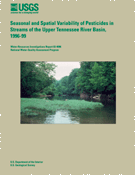

 |
Seasonal and Spatial Variability of Pesticides in Streams of the Upper Tennessee River Basin, 1996-99U.S. Geological Survey, Water-Resources Investigations Report
03-4006 This report is available as a pdf below |
From 1996 to 1999, the U.S. Geological Survey conducted an assessment of pesticides in streams in the upper Tennessee River Basin (UTEN), which includes parts of Tennessee, North Carolina, Virginia, and Georgia. A total of 362 water samples were collected at 13 fixed surface-water sites from March 1996 through June 1999, and an additional 61 samples were collected throughout the UTEN during the spring and summers of 1996, 1997, and 1998. In 1996, 3 of the 13 fixed sites located in agricultural watersheds were sampled intensively (weekly) for about 8 months during the growing season. Water samples were analyzed for 85 herbicides, insecticides, and pesticide metabolites. Based on a threshold concentration of 0.01 microgram per liter, the most frequently detected herbicides were atrazine (59 percent); tebuthiuron (41 percent); the metabolite, deethylatrazine (31 percent); metolachlor (24 percent); simazine (17 percent); and prometon (6.4 percent). The insecticides detected most frequently were carbaryl (6.1 percent), diazinon (1.9 percent), carbofuran (1.7 percent), and chlorpyrifos (1.1 percent). Pesticide concentrations varied seasonally and were closely related to land use. The highest pesticide concentrations occurred in the agricultural watersheds in late spring and early summer (April through July), coinciding with pesticide application and the first substantial storm following pesticide application.
Results of the spatial analysis of pesticides during base-flow conditions indicate
that water-quality conditions at the fixed sites were representative of conditions
in the upper Tennessee River Basin. Although most of the water samples collected
in the upper Tennessee River Basin contained detectable concentrations of one
or more pesticides, none of the concentrations exceeded any human health guidelines.
| AccessibilityFOIAPrivacyPolicies and Notices | |
 |
|